THE RESTORATION OF
THE 146 WURLITZER ORGAN AT CASINO PIER
A STORY OF FRIENDSHIP
Dr. Floyd L. Moreland, Casino Pier, Seaside Heights, NJ
Dr. William E. Black, Carrousel Music, Chambersburg, PA
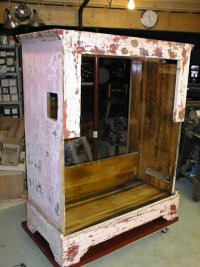 At Casino Pier in Seaside Heights, NJ there has always been the feeling that a carousel without a working band organ is like a lyric without a tune, and over the years great pains have been taken to keep the Wurlitzer 146 playing. The organ has been a good friend that enhances the happy atmosphere that surrounds the carousel. But like any good friend of that age, it requires lots of tender loving care and a watchful eye to tend to any ailments it develops and keeps it in good health. And in recent years, it had shown signs of failing. A good friend of the carousel, Dr. William E. Black, had provided guidance when things went wrong by giving instructions over the phone as to how to repair an ailing pneumatic or a sticking note and by traveling to Seaside Heights to help out when the symptoms became a bit too complex to handle. Several years ago, he rebuilt the entire stack and, after it was installed, he and his friend and mentor, Michael L. Kitner, traveled here one cold winter day to tune the organ and give it a once-over in preparation for the next season. But although it sounded great after Bill and Mike spent the afternoon working on it, the general diagnosis was not good. Major work needed to be done and it was clear that the organ was nearing the point of being on its last legs. In fact, at the end of the summer of 2000, so many hoses and tubes were pumping air into the main pressure bellows and creating additional vacuum at the top of the organ that it looked like a poor soul on life support. At Casino Pier in Seaside Heights, NJ there has always been the feeling that a carousel without a working band organ is like a lyric without a tune, and over the years great pains have been taken to keep the Wurlitzer 146 playing. The organ has been a good friend that enhances the happy atmosphere that surrounds the carousel. But like any good friend of that age, it requires lots of tender loving care and a watchful eye to tend to any ailments it develops and keeps it in good health. And in recent years, it had shown signs of failing. A good friend of the carousel, Dr. William E. Black, had provided guidance when things went wrong by giving instructions over the phone as to how to repair an ailing pneumatic or a sticking note and by traveling to Seaside Heights to help out when the symptoms became a bit too complex to handle. Several years ago, he rebuilt the entire stack and, after it was installed, he and his friend and mentor, Michael L. Kitner, traveled here one cold winter day to tune the organ and give it a once-over in preparation for the next season. But although it sounded great after Bill and Mike spent the afternoon working on it, the general diagnosis was not good. Major work needed to be done and it was clear that the organ was nearing the point of being on its last legs. In fact, at the end of the summer of 2000, so many hoses and tubes were pumping air into the main pressure bellows and creating additional vacuum at the top of the organ that it looked like a poor soul on life support.
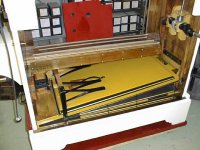 That October, the organ left Casino Pier and was transported to Carlisle, PA, to the Mechanical Musical Instrument Restoration shop owned by Mike Kitner. Since Mike was overwhelmed with other projects, the agreement was that he would orchestrate this restoration provided that his friend Dr. Black do most of the actual work. As the organ was pulled apart, more problems than we had originally projected began to unfold. For some reason (repairs and modifications to the organ over the years had not been carefully documented), there were about 10 pipes in the organ that were not Wurlitzer pipes; a few original pipes were located in the Kitner collection to replace some of these; for others, new ones were made that were the same as the original ones. Lots of crud had accumulated in the internal wind ways in the bottom pipes and many of the mouths had widened over the years. The caps had to be removed, the spaces closed up a bit, and the caps glued back on after careful sanding. Some of the joints had loosened due to glue failure and some of the pipes had nails in them, probably from (unskilled) repairs in the past. New fronts were made for those. In the course of this meticulous work, the organ serial number was found on a trombone (#3673). Don Rand, who has the actual Wurlitzer shipping records in his collection, helped us discover that our organ was shipped on May 6, 1924 to H.M. Barnet (Philadelphia); "Wissahicken" is written by hand on the ledger page. It was a long roll frame Wurlitzer 146A with a white case. (The organ was converted to a dual track system later on). This discovery was helpful in our ongoing efforts to piece together the history of our carousel (at Burlington Island Park in the 1920s) and its organ (an organ going to Burlington Island might well have shipped to Wissahicken Station). More pieces of the historical puzzle were falling into place and were remarkably close to earlier conclusions we had drawn. That October, the organ left Casino Pier and was transported to Carlisle, PA, to the Mechanical Musical Instrument Restoration shop owned by Mike Kitner. Since Mike was overwhelmed with other projects, the agreement was that he would orchestrate this restoration provided that his friend Dr. Black do most of the actual work. As the organ was pulled apart, more problems than we had originally projected began to unfold. For some reason (repairs and modifications to the organ over the years had not been carefully documented), there were about 10 pipes in the organ that were not Wurlitzer pipes; a few original pipes were located in the Kitner collection to replace some of these; for others, new ones were made that were the same as the original ones. Lots of crud had accumulated in the internal wind ways in the bottom pipes and many of the mouths had widened over the years. The caps had to be removed, the spaces closed up a bit, and the caps glued back on after careful sanding. Some of the joints had loosened due to glue failure and some of the pipes had nails in them, probably from (unskilled) repairs in the past. New fronts were made for those. In the course of this meticulous work, the organ serial number was found on a trombone (#3673). Don Rand, who has the actual Wurlitzer shipping records in his collection, helped us discover that our organ was shipped on May 6, 1924 to H.M. Barnet (Philadelphia); "Wissahicken" is written by hand on the ledger page. It was a long roll frame Wurlitzer 146A with a white case. (The organ was converted to a dual track system later on). This discovery was helpful in our ongoing efforts to piece together the history of our carousel (at Burlington Island Park in the 1920s) and its organ (an organ going to Burlington Island might well have shipped to Wissahicken Station). More pieces of the historical puzzle were falling into place and were remarkably close to earlier conclusions we had drawn.
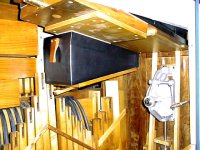 And then tragedy fell. Mike Kitner, who had been battling cancer for several years, became increasingly ill. Although he continued to have a great deal of fighting in him and an overarching will to survive, he finally lost his battle. The world of mechanical music lost one of its most skilled and honored craftsmen. And Dr. Black lost a close friend and mentor. And then tragedy fell. Mike Kitner, who had been battling cancer for several years, became increasingly ill. Although he continued to have a great deal of fighting in him and an overarching will to survive, he finally lost his battle. The world of mechanical music lost one of its most skilled and honored craftsmen. And Dr. Black lost a close friend and mentor.
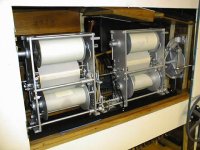 As time went on, more and more seemed to require greater attention than had originally been planned, and the absence of Mike Kitner made the challenges all the more difficult, even as the pain of his untimely death made it more burdensome emotionally to proceed. For example, because the transfer block had been rebuilt several times there wasn't enough "meat" left on the centerpiece after sanding to rebuild it again. A challenging piece of woodworking was undertaken, drilling 350 intersecting holes in specific positions. The main pressure pump required a complete overhaul; this was sent out to Durward Center at his Historical Instrument Restorations shop in Baltimore. All new pump leather was cut, the center boards for both vacuum and pressure pumps were papered and hinged, new flap valve springs were made, as well as new valves. When the pumps arrived, we were stunned at how beautiful they were. The organ was beginning to look like a brand new instrument. As time went on, more and more seemed to require greater attention than had originally been planned, and the absence of Mike Kitner made the challenges all the more difficult, even as the pain of his untimely death made it more burdensome emotionally to proceed. For example, because the transfer block had been rebuilt several times there wasn't enough "meat" left on the centerpiece after sanding to rebuild it again. A challenging piece of woodworking was undertaken, drilling 350 intersecting holes in specific positions. The main pressure pump required a complete overhaul; this was sent out to Durward Center at his Historical Instrument Restorations shop in Baltimore. All new pump leather was cut, the center boards for both vacuum and pressure pumps were papered and hinged, new flap valve springs were made, as well as new valves. When the pumps arrived, we were stunned at how beautiful they were. The organ was beginning to look like a brand new instrument.
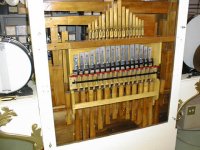 The machine work for the duplex roll frame was sent off to the R & R Machine Shop owned and operated by Bob Ryesky in Carlisle, PA. Beautiful new gears, new drive shaft, and some new small shafts, bronze bushings for long life, a new roller chain and clutch, and some smaller new parts were made. The speed control (which had been removed at some point in the distant past) was rebuilt and the frames were positioned correctly within the case. Meanwhile, Dr. Black continued with his part of the original agreement with Mike Kitner by proceeding with the remaining restoration work. The glockenspiel , which had originally been built and added to the organ in 1986 by Bill Kromer, was reconfigured and repositioned so that it would fit more snuggly in the case and would be visible through the opening in the front. The drums were recovered and refinished. The beater mechanisms on the snare drum appeared to be original; new drum heads were installed. A new motor and drive mechanism were acquired. Dr. Black built a new top for the case and cut pumpsticks from maple imported from Canada for this purpose. There were new hoses, rebuilt valves, even newly carved scrollwork on one of the drum wings--- no part was left untouched. From top to bottom, the organ was beginning to be reborn. The machine work for the duplex roll frame was sent off to the R & R Machine Shop owned and operated by Bob Ryesky in Carlisle, PA. Beautiful new gears, new drive shaft, and some new small shafts, bronze bushings for long life, a new roller chain and clutch, and some smaller new parts were made. The speed control (which had been removed at some point in the distant past) was rebuilt and the frames were positioned correctly within the case. Meanwhile, Dr. Black continued with his part of the original agreement with Mike Kitner by proceeding with the remaining restoration work. The glockenspiel , which had originally been built and added to the organ in 1986 by Bill Kromer, was reconfigured and repositioned so that it would fit more snuggly in the case and would be visible through the opening in the front. The drums were recovered and refinished. The beater mechanisms on the snare drum appeared to be original; new drum heads were installed. A new motor and drive mechanism were acquired. Dr. Black built a new top for the case and cut pumpsticks from maple imported from Canada for this purpose. There were new hoses, rebuilt valves, even newly carved scrollwork on one of the drum wings--- no part was left untouched. From top to bottom, the organ was beginning to be reborn.
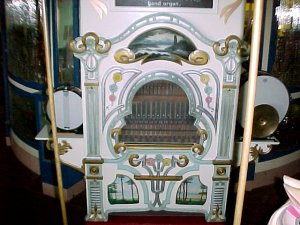 As one rereads the extensive collection of e-mails that were composed over that 8-month period, there is something almost novelistic about them. Beyond emerging as a detailed, textbook-like compilation of the steps and the process involved in pulling apart and restoring an antique organ, complete with photos (perhaps the only such type of document in existence today),* there are two fascinating dimensions that emerge as a subtext. First, there is the unraveling of historical trivia that contributes to our knowledge of the history of this organ -- the discovery of the serial number (which led to our tracing the original date and place of its delivery) and the various parts that had been replaced, removed, or altered over the years (one wonders what considerations might have prompted the alterations that were made prior to the time we began documenting things in the 1980s). Second, and most interesting, is that the communications read almost like a novel, for throughout the process of the rebirth of the organ is interwoven a human interest story filled with challenge, promise, and discovery; the pain of the death of Mike Kitner and the consequent loss of a long-lived tie of friendship; the impetus to move on and use what had been learned from Kitner to bring the project to fruition; the involvement of Durward Center and Bob Ryesky to complete parts of the project that required the honed skills of artisans seasoned in the art of restoration; the jubilation and triumph as the organ began to take physical shape once more and emit its first sounds. The story unfolds within the frame of yet another friendship between the authors of this article, Drs. Bill Black and Floyd Moreland, that developed over several decades as Moreland focussed his energies on keeping a carousel alive and Black focussed his on antique mechanical musical instruments -- unique avocations for a professor of classics and a doctor of dentistry that are fleshed out in the back-and-forth conversations over that 8 month period. As one rereads the extensive collection of e-mails that were composed over that 8-month period, there is something almost novelistic about them. Beyond emerging as a detailed, textbook-like compilation of the steps and the process involved in pulling apart and restoring an antique organ, complete with photos (perhaps the only such type of document in existence today),* there are two fascinating dimensions that emerge as a subtext. First, there is the unraveling of historical trivia that contributes to our knowledge of the history of this organ -- the discovery of the serial number (which led to our tracing the original date and place of its delivery) and the various parts that had been replaced, removed, or altered over the years (one wonders what considerations might have prompted the alterations that were made prior to the time we began documenting things in the 1980s). Second, and most interesting, is that the communications read almost like a novel, for throughout the process of the rebirth of the organ is interwoven a human interest story filled with challenge, promise, and discovery; the pain of the death of Mike Kitner and the consequent loss of a long-lived tie of friendship; the impetus to move on and use what had been learned from Kitner to bring the project to fruition; the involvement of Durward Center and Bob Ryesky to complete parts of the project that required the honed skills of artisans seasoned in the art of restoration; the jubilation and triumph as the organ began to take physical shape once more and emit its first sounds. The story unfolds within the frame of yet another friendship between the authors of this article, Drs. Bill Black and Floyd Moreland, that developed over several decades as Moreland focussed his energies on keeping a carousel alive and Black focussed his on antique mechanical musical instruments -- unique avocations for a professor of classics and a doctor of dentistry that are fleshed out in the back-and-forth conversations over that 8 month period.
Indeed, before the pressure and vacuum pumps had been installed, Dr. Black was able to play the notes by hand using an external source of pressure and the organ was beginning to come to life. Then, when the pumps were returned from Maryland, Moreland received a phone call late one night and was told that someone wanted to say something to him-- and Black turned on the organ in its full glory, with Moreland hearing it once more over the phone lines.
Its return to Casino Pier on May 22 brought grace back to the 1910 carousel that had spent the winter turning to recorded music. The plaque installed on its facade tells the story:
RESTORATION BY DR. WILLIAM E. BLACK
2001
IN MEMORY OF
MICHAEL L. KITNER
And the joy and appreciation of the riders all summer place an appropriate seal on the legacy of this project-- a true labor of love and friendship.
*These will be transcribed and will be compiled into one document, with illustrations.
|